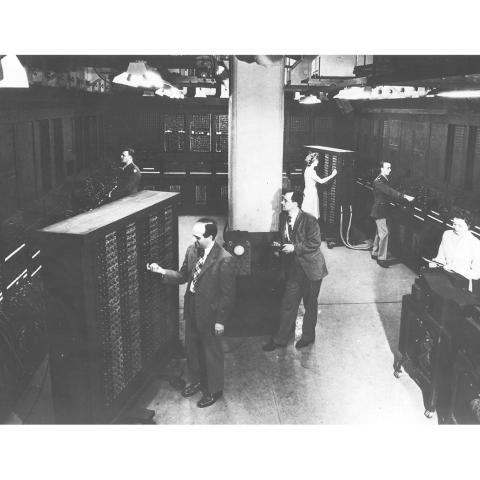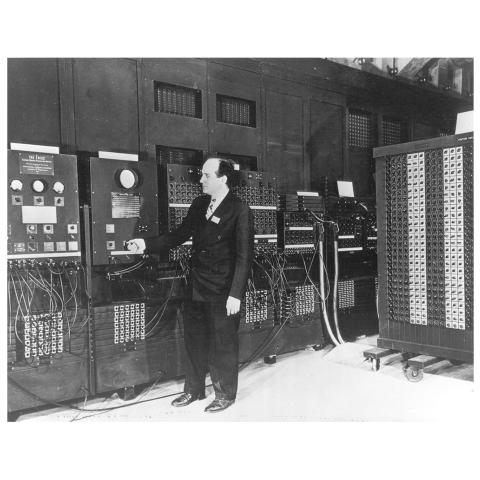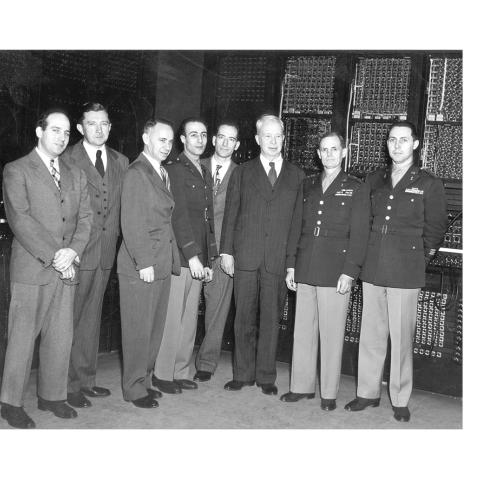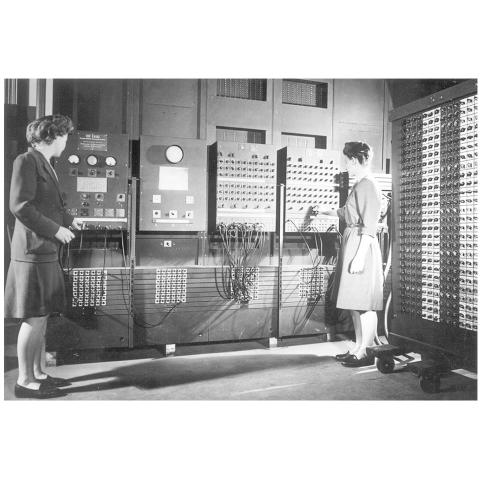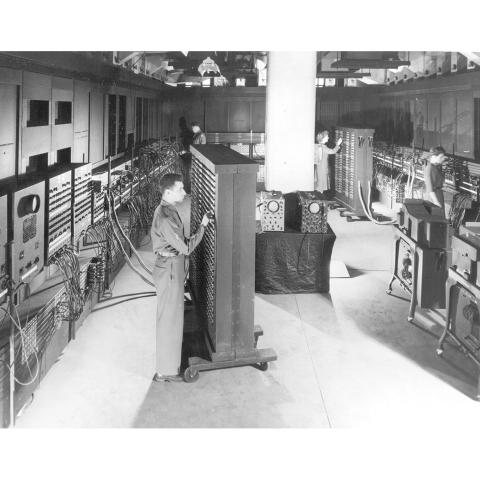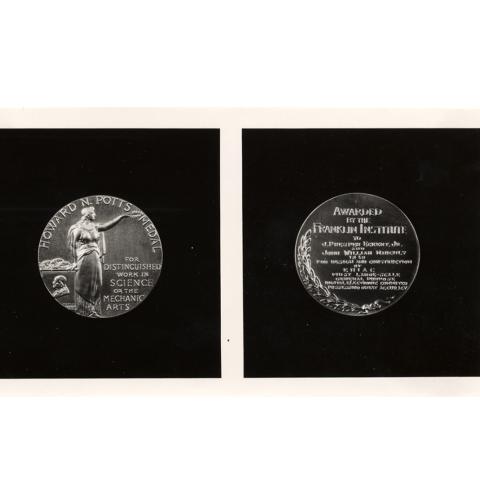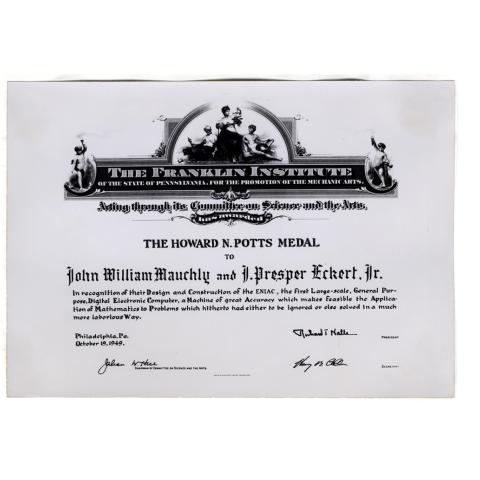
Introduction
The world's first computer was built under classified conditions, welded together to support United States military ambitions in the war-torn years of World War II. An aspiring meteorologist and a recent college graduate teamed up to design and build the ENIAC—the Electronic Numerical Integrator and Computer—in the secure environment of the University of Pennsylvania Moore School of Engineering. The story of Dr. John W. Mauchly and J. Presper Eckert shows how the convergence of mathematical minds, research universities, and laboratories in the U.S. led the country into the Information Age.
Who were Mauchly and Eckert? What were their contributions to computing and electronics?
In the period after the creation of the ENIAC, army liaison officer to the project Herman Goldstine would reflect: "We were young and deeply involved. We felt like the whole war program depended on us...There was a real sense we were doing something very extraordinary" (McCartney 86).
Unlikely Heroes
The world's first computer came in response to a crisis. As World War II raged and U.S. troops headed overseas and into the fray in increasing numbers, military weapons clamored for increased technology. The war-torn years of the 1940s saw major developments in weaponry, notably the German U boats: submarines that stealthily sunk enemy ships. The U.S. military required machines able to calculate differential equations at high speeds and with accuracy in order to improve the efficacy of gun warfare. Specifically, the military was in need of better firing tables. Charts known as firing tables gave the data necessary for properly orienting and firing a gun under standard conditions, as well as data altered to account for special conditions like strong winds or extreme temperatures.
Two unlikely heroes rose to the challenge of creating more accurate firing tables. Presper Eckert and John Mauchly, two young scientists at the time working at the University of Pennsylvania's Moore School of Engineering, developed the "absurd" idea of creating an electronic computer: a computer that would use electricity to "think." The climate of desperation overhanging the country helped gain their idea approval for government funding, and inspired the team of engineers working on the world's first computer to invest long hours and high levels of enthusiasm and loyalty in the project. When Eckert and Mauchly received government funding to support their idea, "Project PX" was underway as a classified military operation. The machine they were developing was formally known as the Electronic Numerical Integrator and Computer, and this ENIAC would have 49-foot-tall cabinets filled with nearly 18,000 vacuum tubes and miles of wiring upon completion.
Exploring Electronics
John Mauchly began fiddling with electronics when he was a young boy, and at the suggestion of his father he went into engineering. He studied engineering on scholarship to Johns Hopkins, but found that he was bored by the time he got to sophomore year. He was, however, intrigued by the field of Physics, and earned a Ph.D. in Physics from Hopkins in 1932. The tall, brown-haired scientist married a mathematician and eventually had two children. He was a calm, charming intellectual who related well to other people and, according to one of his co-workers on the ENIAC project, "seemed to develop many of his ideas in the give-and-take of conversation" (McCartney 83). While holding the position of chairman of the Ursinus College Physics Department, Mauchly began taking an electronics course at the University of Pennsylvania's Moore School of Engineering. He was the oldest student enrolled in the class, and he was assigned to study under the youngest lab instructor in the school. Presper Eckert, who had completed his bachelor's in Engineering at Penn in 1941, assumed the role of Mauchly's instructor. This was the beginning of a partnership and friendship that would launch the development of the world's first computer.
Opposites Attract
Mauchly's easygoing nature provided a favorable foil to Eckert's high-strung personality. Eckert was always electrified with nervous energy, and while working on ENIAC was known to drop into the lab to check on one thing and end up staying the entire night tinkering and brainstorming improvements. He had a funny habit of carrying a pocket watch chain with no watch attached, and twirling the chain continuously when he was aggravated or stressed by something.
Predecessors: The Differential Analyzer
In 1930, an engineer named Vannevar Bush developed a machine called the Differential Analyzer on the campus of the Massachusetts Institute of Technology (MIT). The Differential Analyzer was composed of shafts, wires, wheels, pulleys and 1,000 gears, and was capable of solving only one type of problem. The Differential Analyzer was able to find the solution to differential equations, which are complex calculations that take into account rates of change and curves in order to describe happenings in the physical environment. Differential equations can describe the area lying under a curve or the path of a projectile. These equations were used for creating firing tables because they could describe the area beneath the path of a bullet, and could account for rates of change like high speed winds and high altitudes. The Differential Analyzer was essential to the solving of differential equations prior to the advent of ENIAC.
Slogging Through Analog Calculations
The Differential Analyzer was analog rather than digital. This means that it calculated the correct answer by moving a distance specified by the numbers plugged into a given differential equation. The machine received these numbers through its input tables, into which operators fed numbers and functions. Different units performed different mathematical operations (addition, multiplication, subtraction and division), and different units could be connected in a certain sequence by long shafts. The way in which the connections were made determined how the machine would solve the problem. The machine was less accurate than a digital, or electronic, machine would have been because the solutions it provided were estimates. In addition, as time wore down its many gears and pulleys, the machine grew inaccurate.
Despite its shortcomings, the Differential Analyzer was the most sophisticated calculating device of its time. Furthermore, it helped establish the notion that using electricity to make calculations would provide the fastest and most accurate results possible. The first company to use electricity as a source of speed and accuracy had its roots in the work of Alexander Graham Bell; in the mid-1930s, Bell Telephone Laboratories succeeded in turning the numbers dialed into telephones and the sound transmitted over telephone wires into electrical signals.
Predecessors: Packing a Punch
Data processing first became mechanized in 1890, when Herman Hollerith of the Massachusetts Institute of Technology (MIT) developed a punch-card tabulator for the U.S. Census Bureau. The MIT inventor's inspiration came from watching a train conductor strategically punch a ticket to describe a passenger's physical appearance. The tickets issued on the trains of the 19th Century were known as "punch photographs", and Hollerith's idea was to make a punch photo of sorts of each person counted in the census.
Hollerith's punch cards stored information by using punch locations and combinations to represent certain numbers and letters. Each card could store up to eighty variables, and these variables were read and processed by a tabulating and sorting machine. Inside this machine, spring-loaded pins waited to read the punch cards. When a pin descended through a punch, it completed an electrical circuit, and the electricity produced drove the computer.
Hollerith's machine enabled the Census Bureau to complete the 1890 census in just three years (it had taken nearly seven to process the data from the 1880 census), and at an estimated savings of $5 million. Punch cards technology went on to enable the establishment of the Social Security Administration in 1935; punch cards were enlisted to store wage data on every working American.
Punch cards also proved essential to the operation of the ENIAC; they were used in the initial phase of data input to enter problem data.
Proposing Electricity
Nine months after the attack on Pearl Harbor shocked America into its increased involvement in World War II, Mauchly penned a seven-page proposal with the excitement of an inventor on the verge of a breakthrough. He titled his proposal, “The Use of High-Speed Vacuum Tube Devices for Calculation”, highlighting electricity's ability to calculate at high speeds. Mauchly conjectured: “A great gain in the speed of calculation can be obtained if the devices that are used employ electronic means for the performance of the calculation, because the speed of such devices can be made very much higher than that of any mechanical devices”.
Despite the energetic optimism of its author, the proposal was met with skepticism by the Moore School. John Grist Brainerd, the Moore School's liaison with the army, filed Mauchly's memorandum away, promptly writing off the harebrained idea and losing the proposal amongst the clutter of his filing cabinets.
The Need for Speed
U.S. Army Lieutenant Herman Goldstine appreciated the need for a streamlining of the firing table calculation process. Goldstine had earned a Ph.D. in Mathematics at the University of Chicago before being drafted into the army in July of 1942. He served his military term in the Ballistics Research Laboratory, which was situated in the Aberdeen Proving Ground in Maryland. Goldstine's Ballistics Laboratory was tasked with keeping the army supplied with weapons. The green, hilly landscape of Aberdeen provided the army with ideal artillery testing grounds. When army gunners aimed their artillery guns, they relied on a booklet of firing tables to aim properly. The firing tables helped gunners to alter the aim of their weapons to account for changes in sea level, humidity, wind speed and the like. Each new gun and each new shell had to be accompanied by new firing tables in order to be aimed and used properly. The calculations for the firing tables were performed at Aberdeen based on the results of artillery tests and mathematical formulas.
A team of women performed the calculations for the firing tables by hand using desk calculators. They entered data into the calculators using push buttons and completed each mathematical operation by pulling large handles on the calculating machines. The women who performed these mathematical operations were called “computers”, and it took them more than a month to produce a complete firing table.
The Scramble for Army Support
Dr. Goldstine was tasked with the direction of army operations at Penn and received orders to find a way to get firing tables completed faster. Mauchly's scheme to create an electronic calculator that would take the place of all the "computers" made its way to Goldstine, who immediately recognized the ingeniousness of Mauchly's proposal. Despite the lack of endorsement from Penn's deans, Goldstine tracked down Mauchly and invited him and Eckert to present their proposal at Aberdeen. On the drive to Aberdeen, Brainerd rode in the passenger seat behind an expression of doubt and disbelief that the army would entertain Mauchly's proposal. In the backseat, Mauchly and Eckert were hunched over the proposal in question, frantically rewriting some of the sections which they intended on presenting to the army.
At Aberdeen, Goldstine nervously began pitching the project to Colonel Leslie E. Simon, director of the Ballistics Research Laboratory, and Dr. Oswald Veblen, an accomplished mathematician and technical advisor to the army laboratory. Just a few months earlier, Aberdeen had approved the now-infamous Manhattan Project.
Show Him the Money
Mauchly, Eckert, and Goldstine stood before Simon and Veblen, a bundle of nerves. Dr. Veblen listened for a short period of time before cutting off Goldstine. Leaning back in his chair, he addressed the Colonel: "Simon, give Goldstine the money.” An initial appropriation of $61,700 was allocated for the first six months of work on the project. At the time Mauchly was 35, and Eckert was just 24. Eckert later commented, "Had John and I been five years older and that much more experienced we might have 'known' that a true electronic computer would not be built” (McCartney 61).
The Weather Man
Mauchly's favorite pastime was predicting the weather. He used atmospheric data in experiments, trying to determine if weather patterns could be predicted mathematically. With the help of a desk calculator (purchased for a discounted price of $75), Mauchly conjectured that there was evidence that rainfall in the U.S. was periodic. He realized that if his foray into meteorology was going to produce meaningful results he would need a better, faster calculating machine. He enlisted the students whom he taught at Ursinus to help him develop and assemble various gadgets, and he began taking courses in electronics. He also began ordering parts from corporations across the country, asking about switches and fuses and offering the statement, "I am intending to construct an electrical calculating machine”, by way of explanation (McCartney 36).
Mauchly's tinkering eventually brought him to Iowa State University to visit a young professor named John V. Atanasoff. Atanasoff had attended one of Mauchly's lectures on weather forecasting and knew of his work with electronic calculating machines. Atanasoff, too, had been working with electronic circuits in an attempt to devise an electronic calculating machine. Mauchly went to Iowa to study Atanasoff's prototype, which still did not quite work. Years later, in 1944, Mauchly's path crossed Atanasoff's once more in the Naval Ordnance Laboratory in DC. Atanasoff was in charge of running the lab, and Mauchly did statistical consulting for him once a week in order to bring in extra income. In 1944, he gave up other duties at the Moore School to work on ENIAC full-time, at which point the school's administration cut his salary from $5,800 a year to $3,900.
The ENIAC Team
The ENIAC team was an assemblage of young engineering talents. It included practical jokers, immigrants, and Ph.D. holders, and was led by Mauchly and Eckert with the wholehearted support of Goldstine. The members of the design team were as follows: James Cummings, Kite Sharpless, Joseph Chedaker, Bob Shaw, John Davis, Chuan Chu, Harry Huskey, Pres Eckert, Captain Herman Goldstine, Arthur Burks, Brad Sheppard, F. Robert Michaels, and John Mauchly. Each team member was given a specific piece of the machine to engineer, and every schematic was drawn only after receiving Eckert's approval.
From Calculators to Computers
The desk calculator he initially used for his weather forecasting calculations was a key source of inspiration for Mauchly. He wanted to make the desk calculator electronic, and theorized that if he strung 10 or 20 desk calculators together, they could handle complicated, multi-step problems. The design of ENIAC was based on this notion, and ENIAC's final design was decentralized, meaning that its computing power was spread throughout many units. These units had the capacity both to store numbers and to combine them. The notion of a central processing unit (commonly known today as a CPU) existed at the time of the ENIAC's development, though Mauchly and Eckert did not know of it while working on ENIAC. Most of the engineers assembled to work on ENIAC were, ironically, outside the mainstream of computing research.
The Design
Eckert and Mauchly were cautious when they set out to work on ENIAC. They had a basic design, but they admittedly had not worked out exactly how they were going to realize their plans. They had decided that ENIAC would have three main parts. First, there would be self-contained machines built to handle mathematical operations; these machines would perform addition, multiplication, division, and square roots. Second, they devised memory units to store numbers and instructions. Third, ENIAC required a master programming unit to plug mathematical orders into the machine and to manage the electronic pulses it used to represent numbers and mathematical operations. In addition to these three main parts, ENIAC called for peripheral units that initiated computation and kept calculation synchronized. Though computers have undergone myriad changes since ENIAC, the design outlined by Mauchly and Eckert at its inception remains the basic structure of computers even today.
Mauchly and Eckert wired the units of ENIAC together so that the numbers could be shared from one unit to the next and so that instructions could be sent over electronic cables. The two scientists bundled these cables together and arranged them in phone-like trunks they called digit trays. Each digit tray had 11 wires so that it could carry a 10-digit number and a plus or minus sign. The digit trays were permanently wired throughout ENIAC.
Mauchly and Eckert designed moveable trays called program trays, which could also carry 10-digit numbers and a plus or minus sign. The program trays, however, could be moved around and plugged in to send signals either to the entire machine or to specific units. These program trays were the electronic equivalent of the shafts that connected the various units of the Differential Analyzer.
Safeguarding
One malfunction had the potential to throw off ENIAC's entire calculation, and Eckert and Mauchly worked tirelessly to guard against potential kinks in the system. Telephone company workers were hired to do the wiring inside ENIAC, in hopes that their years of experience would enable them to produce the flawless wiring job necessary for the correct function of the computer. In order to determine the optimal type of wire to use, Eckert locked some mice in cages and starved them for several days. He then tempted their appetites with several different types of wire, and the brand they seemed to enjoy eating the least was the one selected for use in ENIAC. To prevent the almost 5,000 knobs used in the manufacture of ENIAC from getting loose too easily, Eckert designed his own knobs and secured them with specially made screws.
Control Issues
The biggest challenge facing Mauchly and Eckert was devising a means to control the circuits responsible for counting the electronic pulses. The basic science of getting circuits to count had already been developed, but Eckert and Mauchly had to ensure that the right pulses got to the right circuits, and that the circuits counted in the right order at the right time.
The ENIAC team began working on the accumulators of the machine first. An accumulator is a kind of register that receives a number and produces and stores the results of arithmetic operations of the given number with other numbers. The accumulators in ENIAC were designed not only to store numbers, but were also able to add and subtract them and transmit them to other units of the machine. By connecting the wires carrying data from one accumulator to the wires controlling operations in another, the ENIAC could control those operations based on the content of its data. These types of operations are known, even today, as "data-sensitive operations," and the ENIAC was probably the first electronic machine to be able to perform such operations.
Since the accumulators could store a number with as many as 10 digits, Eckert and Mauchly split each digit of a given number into its own circuit, rather than building the accumulator to count electronic pulses to reach a number. This meant that the number 444, for example, did not require 444 pulses in order to be represented electronically within ENIAC. Rather, it required 4 pulses in the hundreds circuit, 4 in the tens circuit, and 4 in the ones circuit—a total of 12 pulses instead of 444. This design greatly increased the speed of the machine. Though its structure was large and included many components, the simplicity and practicality of ENIAC's design was what enabled the master programmer to exert the control necessary for the success of the computer.
Vacuum Tubes and Flip-Flops
Vacuum tubes were a key element of the early success of the electronic age. Vacuum tubes allowed for the easy regulation of electricity, and they functioned like on-off switches. All vacuum tubes, from the simple to the more complex, contained an emitter and a collector. The collector "collected" incoming electricity, and the emitter "emitted" it in forms such as light. The ability to turn on and off very quickly was what inspired John Mauchly to consider the possibility that counting could be accomplished by representing numbers with electrical pulses. These pulses, he hypothesized, could then be controlled and counted with vacuum tubes. Mauchly estimated that using vacuum tubes in this manner would enable calculations to be performed in roughly two-hundredths of a second – much faster than calculations performed by the Differential Analyzer. Vacuum tubes would become a critical component of ENIAC, and the completed ENIAC would contain nearly 18,000!
Another key element of the success of the electronic age was the “flip-flop”. Designed in Bell Telephone Labs by research mathematician George M. Stibitz, flip-flops were circuits of relays that could count based on the flow of electricity. The circuit had lamps that glowed for the digit 1 and were dark for the digit 0. It coded traditional base-ten numbers as a series of 1s or 0s. In ENIAC, flip-flops composed of vacuum tubes enabled the first computer to represent numbers electronically.
The Decade Counter
In ENIAC, vacuum tubes were used as on-off switches and were instrumental in the success of the counting circuits which Eckert developed. ENIAC's counting circuits contained ten flip-flops, and each flip-flop was made up of two vacuum tubes. Eckert wired the flip-flops so that only one tube could be on at a time. If vacuum tube A was on and the next pulse came in, the flip-flop flipped to vacuum tube B on, A off. Each electronic pulse resulted in a "flip-flop" of electricity, so that the flip-flop that remained on at the end represented the final sum (for example, if ENIAC wanted to add three and five, only flip-flop eight would be on at the end of the calculation). Each counter thus had twenty vacuum tubes to represent each ten-digit number, and eight other vacuum tubes that represented plus or minus signs and other controls. Eckert's decade counter provided the crucial technology for turning pulses into numbers.
Expedited Engineering
Because of the ENIAC's status as a wartime project, its engineers were forced to work expediently and to develop reliable, straightforward designs. Even as they drove the ENIAC towards completion, Mauchly, Eckert and their engineering team members were devising methods of simplifying the process of programming and wiring the machine. Mauchly and Eckert entered into joint discussions with accomplished mathematician John von Neumann, out of which came plans for the EDVAC: The Electronic Discrete Variable Calculator. Von Neumann drafted a report entitled "First Draft Report of the EDVAC Design”, which Goldstine circulated widely. The dissemination of this document made public the knowledge of the EDVAC, and made controversial the question of which parties should be credited with its creation.
Resignation
With the permission of the Moore School, Mauchly and Eckert applied independently for the ENIAC patent. However, new government policies issued in the aftermath of World War II prompted the University of Pennsylvania to demand that Mauchly and Eckert turn patent rights back over to Penn. Mauchly and Eckert did not oblige, but rather resigned in March of 1946.
The pair formed the Electronic Control Company in Philadelphia, where they used von Neumann's report to develop and build the UNIVAC—the UNIVersal Automatic Computer I. Their first client was the U.S. Census Bureau, and despite the UNIVAC's success in data processing for this and other clients, the high cost of developing a commercial computer led Eckert and Mauchly to sell their company to Remington Rand in February of 1950. Both men nonetheless went on to have successful careers and were acknowledged for their role in the development of the first computer.
Validation
Though the ENIAC patent was invalidated by the U.S. District Court in Minnesota, Eckert and Mauchly have nonetheless been credited by history with inventing the ENIAC, the world's first large-scale general purpose electronic computer. The Franklin Institute acknowledged their work with the Potts Medal in 1949, and the American Federation of Information Processing Societies with the Harry Goode Medal in 1966.
The Eckert and Mauchly presentation was made possible by support from The Barra Foundation and Unisys.
Thanks to the Collections of the University of Pennsylvania Archives.
Read the Committee on Science and the Arts Report on Mauchly and Eckert’s work with ENIAC, the first electronic computer.


